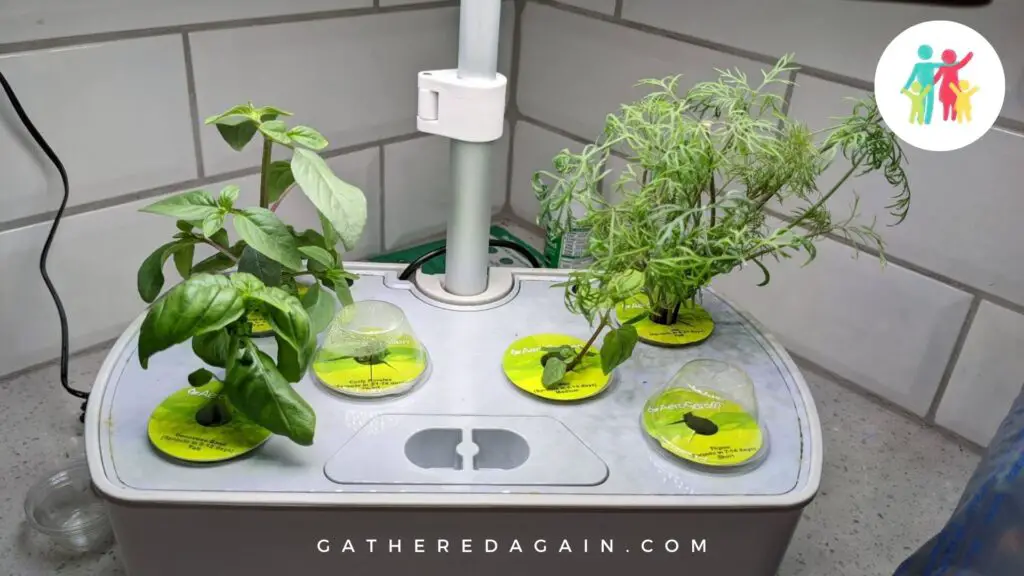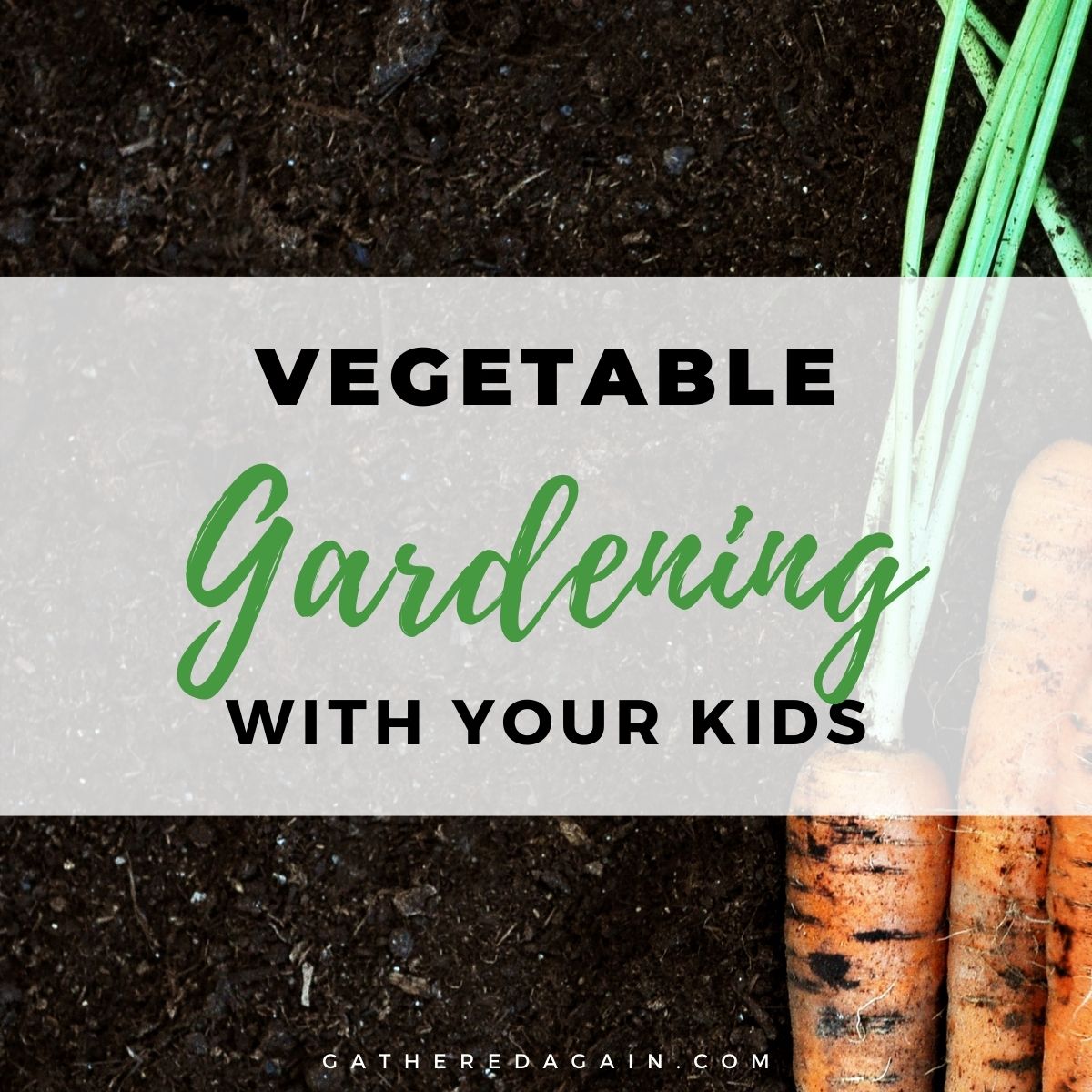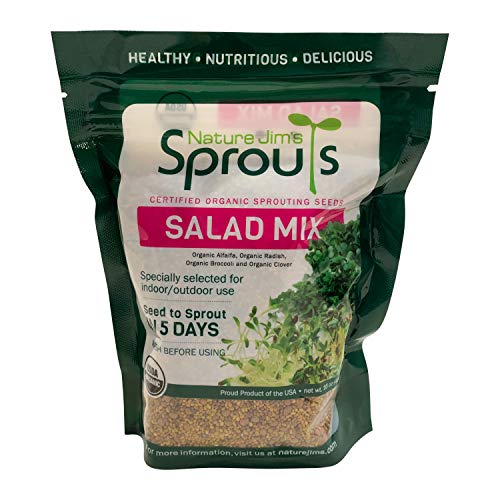You’re about to learn how to enjoy some family bonding time with your kids while teaching them how to grow their own food and the benefits of gardening! I’ll also include my simple hack that makes it almost effortless. I also reveal the standard advice everyone seems to give, but you probably shouldn’t follow! We also use my gardening hack to teach botany basics for homeschool.
I find that teaching my kids about the world we live in is the most rewarding quality time I can spend with them. I love teaching them about how their food grows rather than letting it be a grocery store mystery! It empowers my incredible children and will hopefully leave them with lasting memories.
Why You Should Garden With Kids
Firstly, there’s nothing like hearing the awe and amazement from your little ones. Kids can take the most ordinary things and see the true miracles in it all. The other day, my son asked me to go “cloud gazing” with him. I can’t remember the last time I looked at the clouds other than to check if it was about to rain.
It’s easy to think that gardening with your kids is all about them, but they can certainly teach you a life lesson or two!
Next, gardening with your kids gives them a sense of responsibility. Kids are so used to being taken care of that it’s a significant change for them to know that something is now relying on them! That’s what makes this a great activity for children.
Finally, one of my favorite reasons is that it teaches kids that food isn’t a mystery. It teaches them that they have the power and skills to feed themselves. Growing food is one of the most important and beneficial life skills!
It also teaches them how much work people put in for food to appear on the dinner table, which is a precious lesson.
Teach Your Children About Plant Hardiness Zones
If you’re brand new to this, don’t be intimidated! The USDA identifies what they call “plant hardiness zones.” You can see all of the different zones, including which zone you’re in, on the USDA Plant Hardiness page. These zones tell you which plants are well suited for specific areas.
If you look at the back of your seed packets, they’ll tell you how that particular plant does in different zones and which times of year you can grow it in your zone.
This is important because sometimes your kids might be excited about something that you just can’t grow in your yard. For example, my oldest son handed me some seeds from an apple he had eaten and wanted to grow a tree from the seeds.
Here’s the thing: we could grow the tree, but we’re in zone 9 (hot, hot weather!), which means that the apple tree will never produce fruit. Apple trees need a certain number of “chill hours” to produce fruit. Do you want to know what zone 9 doesn’t get? Chill hours!
Teach Your Kids About The Weather and Seasons
The good news is that while many things are tough to grow in certain areas, it’s usually only limited by the time of year you plant the seeds.
For example, with Romaine lettuce, if you’re in Greenbay, Wisconsin (zone 5), you’ll want to plant it in April. If you’re in Dallas, Texas (zone 8), then planting it in April would likely kill it if it grew at all because of the heat. That’s why the back of the seed packet says to plant it from February to March or August to September for that area.
It’s also important to know about rain, which we’ll discuss in the next section.
Understanding Your Water Sources
Your plants need water, and your kids probably know this. What many people don’t know is how much water and where that water will come from. For example, suppose you live in an area that gets reliable precipitation. In that case, you can perhaps depend mainly on the rain to do the watering for you. If not, then you need an alternative water source.
The amount of physical labor involved will depend on you. If you want your kids to get a lot of physical activity, you can water the plants manually each day. You can use a traditional watering can or a plant mister if you water something small like a seedling or a tiny herb garden.
You can also use a soaker hose, which is basically a hose that runs along the ground and slowly releases water as it goes. This is great for small plants like herbs and flowers.
Prices pulled from the Amazon Product Advertising API on:
Product prices and availability are accurate as of the date/time indicated and are subject to change. Any price and availability information displayed on [relevant Amazon Site(s), as applicable] at the time of purchase will apply to the purchase of this product.
Or, you can invest in a drip irrigation system, but this is definitely for people who are very serious about gardening. You can also set up a sprinkler on a timer, so it waters each day consistently for the right amount of time.
Prices pulled from the Amazon Product Advertising API on:
Product prices and availability are accurate as of the date/time indicated and are subject to change. Any price and availability information displayed on [relevant Amazon Site(s), as applicable] at the time of purchase will apply to the purchase of this product.
You want to watch for how the plants are looking and avoid overwatering. Watch for limp, yellowing leaves; this is a common sign of overwatering. You want your soil moist but not drenched!
Backyard Garden Vs. Container Garden?
Which kind of garden should you create? Ultimately, that depends on your backyard size and commitment to the project.
If you have room for a large garden and a passion for gardening, go big. A container garden gives you more flexibility than a backyard garden does. It’s easier to move around, and it’s easy to add new containers when you decide to expand.
Digging up a part of your yard for a garden bed is a big commitment, so it might be better to start with containers. This is especially true if you’re doing this for your children more than for your own enjoyment. One thing to keep in mind with container gardens is they are more maintenance for water because they dry out quickly. Also, they don’t have the luxury of a yard to draw their water from.
Don’t Forget About Community Gardens!
Community gardens give you access to fresh produce without having to dig up your yard. Many large communities offer community gardens, and some even allow you to rent plots. Many cities also have programs where you can buy a share of a plot of land. This is a great way to be around people who know more about gardening than you and learn!
The best part is that you can grow whatever you want and choose what you want to eat. Some people choose to grow food for themselves, while others prefer to grow food for their neighbors. Either way, you’ll learn a lot about growing vegetables, fruits, and herbs.
The Common Advice You Should Ignore
The common advice here is to grow what you enjoy eating. Unfortunately, I followed this advice and failed miserably, and I know others have as well.
Here’s the thing, what you enjoy eating might be really difficult to grow. So here’s an example, I don’t suggest you start with tomato plants. Want to know why?
- Trellises
- Too much water (causes the tomatoes to crack)
- Too little water causes the plant to wilt.
- They are susceptible to pests and disease
It’s funny because I read lots of gardening blogs that talk about how easy tomatoes are to grow, then they go into a long-winded list of dos-and-don’ts. For example, don’t use those tomato cages; use the “Florida weave” method instead. Don’t water every day for 15 minutes; water once a week for one hour. And so on.
I understand the logic: if you grow vegetables you don’t like, you won’t eat them. BUT! If you grow super simple veggies that you can tolerate eating, you’ll gain experience and confidence. For example, you may not love radishes, but if you grow your own, that’s a game-changer. It also may force you out of your comfort zone and encourage you to find recipes in which you actually like that vegetable!
Do you want to know the truth? Tomatoes are easy for experienced and semi-experienced gardeners. However, they are not an excellent first vegetable for beginning gardeners.
What Happened When I Followed The Common Advice?
I fell into this trap when I first started. I even took a shortcut: I purchased a tomato plant from a garden center that already had a cage!
This is what happened:
- The plant grew too large for the planter, so I had to transplant it. (Lots of problems can happen from transplanting alone!)
- The plant grew too heavy for the cage, so I had to re-trellis the plant. That was very difficult to untangle.
- I got a few cherry tomatoes from the plant, but the plant became heavily diseased.
Will I ever grow tomatoes again? Absolutely! Should I have started with tomatoes? No. It was very discouraging and labor-intensive. Was the failure my fault? 100%, but that’s why I don’t tell people to follow the advice of “grow what you love to eat.” It can lead you into very frustrating situations.
Which Vegetables Should We Grow? What Are the Best Vegetables to Grow with Kids?
My parameters for the “best” vegetables to grow with kids are simple:
- They aren’t particularly needy or sensitive to changes.
- They grow quickly
- They don’t require trellises.
- They don’t require pollination to enjoy.
- They are generally liked by lots of people.
Radishes
I already let the cat out of the bag a bit, but radishes are an excellent one to start with. They’re easy to grow, and more importantly, they grow quickly! Some varieties are ready to harvest in 3 weeks!
Prices pulled from the Amazon Product Advertising API on:
Product prices and availability are accurate as of the date/time indicated and are subject to change. Any price and availability information displayed on [relevant Amazon Site(s), as applicable] at the time of purchase will apply to the purchase of this product.
Scallions
In my opinion, scallions are delicious. They make an excellent garnish on almost any food, but they also freeze well. So you can make soups with them, top baked potatoes with them, and sprinkle them on store-bought french onion dip to make it look gourmet! Even better, they also grow quickly!
Prices pulled from the Amazon Product Advertising API on:
Product prices and availability are accurate as of the date/time indicated and are subject to change. Any price and availability information displayed on [relevant Amazon Site(s), as applicable] at the time of purchase will apply to the purchase of this product.
Thai Basil
Thai Basil is very satisfying to grow because the seeds germinate quickly, and the plant soon grows big, beautiful leaves! It’s so fragrant and lovely. It reminds me of the times my husband and I would get a giant, steamy bowl of Pho soup at our favorite Vietnamese restaurant.
Prices pulled from the Amazon Product Advertising API on:
Product prices and availability are accurate as of the date/time indicated and are subject to change. Any price and availability information displayed on [relevant Amazon Site(s), as applicable] at the time of purchase will apply to the purchase of this product.
Dill
Have you ever heard the phrase “it grows like a weed?” There’s a reason dill is also called dillweed. Dill grows like it has something to prove. I’m shocked at how productive our dill plant has been. I’ve had to harvest it 4 separate times in the first month, while some of my other plants have had either no pruning or one pruning.
Prices pulled from the Amazon Product Advertising API on:
Product prices and availability are accurate as of the date/time indicated and are subject to change. Any price and availability information displayed on [relevant Amazon Site(s), as applicable] at the time of purchase will apply to the purchase of this product.
Lettuce
I believe that there is a salad for everyone. With the right mixins and dressings, you can please almost anyone with a salad. Lettuce is another friendly way to introduce yourself and your children to vegetable gardening. You also get a lot of lettuce seeds in a single pouch. It’s shocking how big lettuce gets from such a tiny seed.
Prices pulled from the Amazon Product Advertising API on:
Product prices and availability are accurate as of the date/time indicated and are subject to change. Any price and availability information displayed on [relevant Amazon Site(s), as applicable] at the time of purchase will apply to the purchase of this product.
Microgreens
This might sound fancy, but microgreens are just really immature plants. There isn’t just one type of microgreen, either. Microgreens can be broccoli, peas, arugula, radish, chia, mustard, kale, and more.
You just harvest the seedlings before they have a chance to grow into mature plants.
The idea behind microgreens is to put a ton of seeds into a germination tray and let them grow for about 2-3 weeks. Then, you harvest these little plants before they develop into mature plants.
Why do this? Firstly, they’re super nutritious. The USDA and a few universities did a study that found microgreens to have 4-6 times the nutrients compared to mature plants. Secondly, they grow very quickly, which is satisfying. Finally, you get a lot of growth in a small space.
Don’t attempt microgreens with those little seed packets, though. Instead, you must buy “bulk seeds” from a seed company or Amazon. You can check with your local garden center, but it’s hit or miss in my experience.
Buying bulk seeds is not expensive at all (in fact, per seed, it’s way cheaper than you can buy a seed packet at Walmart or Target).
Prices pulled from the Amazon Product Advertising API on:
Product prices and availability are accurate as of the date/time indicated and are subject to change. Any price and availability information displayed on [relevant Amazon Site(s), as applicable] at the time of purchase will apply to the purchase of this product.
My Secret Hack: Indoor Gardening
If you’re like me, some of the above complications can be overwhelming. When you factor in family responsibilities like:
- school
- work
- swim lessons
- soccer practice
- cooking
- cleaning
- and any other family responsibilities
Gardening might lose its appeal.
That’s when I discovered indoor gardening! Don’t get me wrong, I love outdoor gardening, but if you don’t have the time, or you don’t have a yard, then it’s not going to happen! So indoor gardening was the secret to my starting a successful vegetable garden.
The Best Way To Start With Your Kids
There are lots of ways to do indoor gardening. Some are cheap, like a little planter on your kitchen window sill; others are a bit pricier but super convenient and nearly foolproof.
Let me tell you about the way that has worked best for me so far. It’s called an AeroGarden. It’s a form of hydroponic gardening, fancy-speak for growing plants in water rather than soil.
My husband bought the AeroGarden Harvest Elite garden kit for me as a gift, and it was the absolute best thing to ever happen to our indoor gardening. So say goodbye to garden gloves!
Prices pulled from the Amazon Product Advertising API on:
Product prices and availability are accurate as of the date/time indicated and are subject to change. Any price and availability information displayed on [relevant Amazon Site(s), as applicable] at the time of purchase will apply to the purchase of this product.
What Did the AeroGarden Kit Come With?
It comes with everything you need to start growing plants on your counter. Guests are always amazed when they see what we’re doing.
In the kit, you receive the AeroGarden, which is a water reservoir, silent pump, grow lights, the nutrients for the water, and a starter kit of 6 “pods” that allowed me to grow my herb garden on my kitchen counter.
Here is a photo of the AeroGarden once our herb garden started growing:

How We Used The AeroGarden To Teach Our Kids
My kids love checking on it, and it works really well. It’s really encouraging to see my kids excited about plants growing. It has made for an enjoyable activity.
My husband made a little science observation printout for our kids and let them put the pods into the AeroGarden independently. They now watch “their plants” grow, and it’s a fantastic way to teach children about gardening basics. I also like that it opens us up to questions from the kids about the different aspects of gardening. Questions like “why do people garden outside rather than do it like this?”
Here is a picture of our first herb harvest from the AeroGarden:

Prices pulled from the Amazon Product Advertising API on:
Product prices and availability are accurate as of the date/time indicated and are subject to change. Any price and availability information displayed on [relevant Amazon Site(s), as applicable] at the time of purchase will apply to the purchase of this product.
The Pros of Indoor Hydroponic Gardening With Kids
My favorite parts of gardening with an AeroGarden are that there is no soil, no compost, and no overwatering or underwatering. It tells us when it needs more water, it tells us when it needs more nutrients, and it looks charming on my counter.
Additionally, it’s a perfect introduction for someone who lives in an apartment or doesn’t have access to gardening space. If you have limited space in your yard or house, you should give one of these a look. Also, indoor gardening might be a great idea if you live in a place with poor soil.
Soil is another gardening topic that can quickly become overwhelming. PH balance, acidity, alkalinity, nutrients, bacteria, pathogens! It’s incredible how much there is to know about soil. Of course, you don’t have to be a soil expert to start, but it’s easy to fall down that rabbit hole!
Finally, with indoor gardening, you can garden year-round. It doesn’t matter which zone you are in or if you have a foot of snow outside. You can still grow almost anything. Do you want to grow an okra plant in North Dakota during November? Go for it!
The Cons of Indoor Hydroponic Gardening With Kids
The biggest con of indoor gardening, especially with a garden kit like the AeroGarden, is that it removes most of “the struggle” from gardening. This sounds like a good thing, but remember, one of the reasons I enjoy teaching my kids about gardening is that I don’t want food to be a mystery. These kinds of devices add some of that mystery back.
It has been a great introduction to gardening for my kids. Additionally, I think it will inspire them to grow vegetables in pots. I hope to start a backyard garden once my younger kids are older.
Additionally, it’s harder to grow things like melons, squashes, trellising plants, and trees. This is because you’re limited to the size of your system. You can still grow things like jalapenos, tomatoes, and cucumbers, but your system will start to look a bit hodge-podge.
In these cases, people might start their plants in an AeroGarden, or indoors, then transplant them into planters or garden beds once they’re strong.
Conclusion: Enjoy Better Food and Better Experiences By Growing Vegetables With Your Children
I hope this review helps you decide whether or not you’d like to try vegetable gardening with your kids.
I’ve tried to provide many helpful tips on your options and share what ended up working best for my family. I’ve enjoyed using the AeroGarden and would recommend it to anyone looking to start indoor hydroponic gardening.
What are you considering doing? Do you plan to do container gardening? Have you tried a community garden in the past? What has been your experience with growing vegetables with your kids? Let me know in the comments!
















